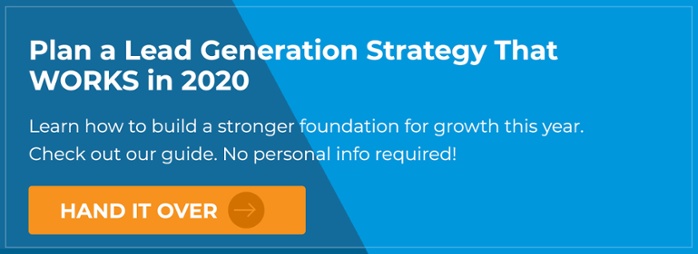
HubSpot Onboarding: How to Work With Your Agency Partner
Patrick Dodge
Founder
The day has come!
You’ve signed an agreement with a HubSpot partner, and are ready to dive into a whole new stage of growth for your company.
This is an exhilarating time for everyone involved, but before the ink is dry, you need to start planning.
The first 30 to 90 days of onboarding and campaign management will define the success or failure of your entire partnership.
Which way yours will go depends on how the process and communication are managed. Even a completely outsourced solution requires a great deal of collaboration on both sides.
I can share many personal insights about this process, but I didn’t go through it alone.
James Desmond is a HubSpot consultant who helps agencies and clients be successful with inbound sales and marketing. He has worked for two top tier agencies in the U.S. – Impact and BlueLeadz – and has been a valuable part of our team at Creative Side for some time.
I asked James to share his thoughts about the most important steps to kicking off a long and profitable relationship.
Avoiding Problems With Your Marketing Agency
Desmond says the biggest issues that come up between client and agency are usually rooted in mismanagement of the process. The most common problems are related to:
- Wrong expectations
- Poor communication
- Confusing priorities
- Missed deadlines and deliverables
These challenges can spell disaster for your new partnership.
Desmond has witnessed this first hand. It’s not pretty.
He says most of these problems can be managed or avoided entirely by creating a clear plan during the onboarding process, and then sticking to it.
Schedule HubSpot Kick-Off Meeting Right Away

No more than one week after signing the agreement, Desmond says it's critical to bring all stakeholders together for the kickoff meeting.
This is mandatory for everyone involved. No exceptions.
“We required everybody to be on the onboarding call,” he says. “Just one hour. There’s no reason why everybody can’t make it and get on the same page.”
The information that comes out of this meeting will form a foundation for your agency’s lead generation strategy. This is why Desmond says it's critical for everyone to come to the table ready to participate immediately after the contract is signed.
Here was what the agenda looks like:
Introduce the teams – Everyone introduces themselves and explains what their role is.
Set SMART goals – You and the agency contact have discussed goals throughout the sales process. Now is the time to set them in stone. After that, your new partners can use the information to back out the metrics needed to attain those objectives in your lead generation campaign.
State the plan – The agency explains the tactics required to close the gap between where you are now and the goal.
Confirm marketing challenges – Reaffirm the challenges your organization has faced in the past and how your partners will address them.
Creating a timeline – Your agency will provide a list of deliverables and tasks to be completed throughout the onboarding. It sets the expectation of what will happen and when as they set up your HubSpot portal, build a strategy, and create a process that will enable your teams to work together.
Defining responsibilities – During the onboarding and throughout the campaign, both parties will have certain roles and responsibilities. We need to define who is responsible for what and when, so there is no risk of scope creep or dashed expectations.
“We called it a road map,” Desmond says. “It outlines exactly what to expect this week, and what to expect next week. If either party delays on their responsibilities, it’s going to end up effecting everything kind of down the line. If you can set up a guide at the start of the relationship, it helps makes the process smoother as things pick up and everybody gets busy.”
Determining KPIs – Regardless of their involvement in the process, stakeholders in your company will likely be interested in different performance metrics. The CEO, sales manager, and social media manager may all have different priorities. Document which KPIs they need during the kickoff meeting so the agency can make sure they stay on top of them.
Gather Information the Agency Needs
Your HubSpot partner has already gathered some insights for putting a strategy together. More often than not though, they will need additional information from you to fill in the gaps.
Here are a few lists Desmond advises you to go by:
Technical Checklist
These questions outline the steps required to getting HubSpot integrated with your existing website, or building a new one on the HubSpot CMS.
If you are sticking with your existing site, you will need to work through a number of questions with your agency partner:
- Who will set up the subdomain for your HubSpot landing pages and blog?
- Who will replace the forms on your website with HubSpot forms, and migrate your existing blog content to the new platform?
- How will the agency integrate HubSpot with your CRM, streamlining all the data for your sales team to use with prospects and customers?
- Who will install the HubSpot tracking code on the website?
These are just a few questions that need to be answered as the on boarding process begins.
Content Audit
Content is the fuel that powers your lead generation engine. Before your partner draws up a plan for creating it, they should spend some time assessing what you already have.
Clients often have more useful content than they realize.
Marketing collateral, sales sheets, presentations, training materials, and other resources you use to educate clients are useful.
Even emails your salespeople have sent to customers and prospects can be content goldmines. Ask them to dig into their inboxes and look for messages they’ve sent to buyers. These messages can make great blog topics.
Questions for the Content Team
- Define who will create content, and what formats they will use (blog, video, graphics).
- Who will research topics and manage the editorial calendar?
- Who are the biggest thought leaders within your niche or industry?
- Are there other people in the organization who can contribute in some way?
Set Up the Approval Process
- How much time do people need to research and create each content piece? Make sure that timeline is accounted for in the planning calendar.
- Are there regulatory or legal considerations that must be addressed?
- Who approves the final draft before publication, and who will fill in when that person is unavailable?
The goal here is to streamline the process as much as possible. The fewer hands your content needs to pass through, the easier it will be to stay on track and avoid blowing deadlines.
Questions for the Sales Team
- Explain what your sales process is like to your agency, including average time from first contact to close.
- Who will be the agency’s point of contact for new sales qualified leads?
- What are the most common objections of prospects? List all “deal breakers.”
- What criteria defines your best customer? Use buyer profile attributes like company size, industry, annual revenue, and number of employees. Other important insights will come out when your partner conducts buyer persona research.
Define the Communication Process

Communication is critical in the early stages of an inbound marketing partnership, but things can quickly get out of hand without a process.
The last thing you need is everyone in your organization emailing the agency about different questions and concerns. When too many people have a direct line to your partners, plans fall apart, results tank, and frustrations build on both sides.
One or Two People Lead the Two Teams
“In my experience, you need one or two people on the agency team and your team and keep the communication going between them only,” Desmond says. “This is especially true when you are working on design and technical projects.”
Use Project Management Software
He says a lot of this can made easier by working with a project management app like Basecamp, Asana, or Trello. “When the team can go in and see what’s going on at any time, it really helps cut down on the back and forth."
It’s also useful to use a chat app for quick communication, and save email for more formal messages.
Conversations that go back and forth through email make it hard to manage information, whereas apps like Slack allow you to set up channels for chatting about specific projects.
“I like to try to keep all conversations siloed, whether it’s in project management software or in Slack. There’s one channel for blogs, there’s one for the website, and it helps keep those conversations and members siloed and avoid distractions like you get where you have a big open forum or an email with 30 people copied on it.”
Complete Tasks, Set Next Steps
As you progress toward the campaign launch, you and the agency should meet weekly or bi-monthly to review completed tasks, discuss new priorities, set the agenda for next week, and always put a date on the calendar for the next meeting.
Everyone should leave with a clear understanding of what happens next and when the team will reconvene.
The steps above may sound like a lot of work – I won’t lie to you, it is – but you will find that as the campaign moves along, everyone involved will find their groove and things will get easier.
The first 30 to 90 days are challenging, but manageable when everyone involved is invested in making the campaign a success. This is why finding a good fit is so very important when partnering with an agency.
When you find one that shares your passion and drive for success, there’s no limit to what you can accomplish together.
Apr 28, 2018 9:25:58 AM

